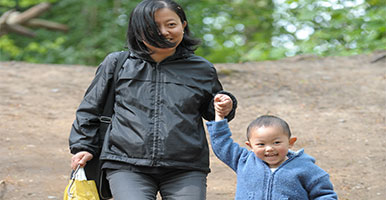Guiding and directive approaches

Communication techniques to try out
Below are some ideas for how practitioners can use a guiding approach (and support parents/carers' autonomy, competence and relatedness). Most importantly, this approach is about getting to know the parent/carer and family (i.e. their lifestyle, preferences, constraints), coming from their perspective (i.e. what does it feel like to be them?) and helping them set appropriate goals that fit within their lifestyle (i.e. tailoring support to the individual).
After reading each technique, ask yourself how much you currently use this and how you might implement it into your practice.
For some practitioners these techniques will come naturally, or you may be practicing in this way already. If this is you, the following section may simply affirm what you are doing and provide you with confidence in your approach.
For other practitioners, these techniques may be new and may appear a daunting task. If this is you, be reassured by the fact that many people feel this way. People think communication should be easy but in fact can be very challenging. Rather than trying to implement these techniques all at once, perhaps pick one or two to try out first. Then once you are comfortable with them, come back to the module and move onto some more techniques.
Faq Items
Talk the parent/carer through the consultation
Ask open-ended questions to find out about the parent/carer's needs
Reflect back what the parent/carer has told you to acknowledge their needs and demonstrate you are listening (reflective listening)
Offer the parent/carer opportunity to have a choice in any areas of change (e.g. physical activity and diet)
Ask permission to give advice or ask personal questions
Provide meaningful rationale for suggestions (e.g. physical activity and diet)
Offer meaningful and specific praise/feedback:
Use summarising statements:
Give the parent/carer space to ask questions or request clarification:
Communication techniques to avoid
It is important to minimise the use of the following communication techniques. These directive strategies can be perceived as controlling by parents/carers, and reduce parents/carers’ sense of autonomy, competence and relatedness:
Faq Items
Use jargon, or technical terms that the parent/carer might not understand
Tell the parent/carer they 'must' (not) or 'should' (not) do something
Use forceful 'if, then' language
Activities to help develop a guiding approach
Activity 1 - identifying communication strategies
In the videos below the practitioner is using two different approaches to discuss a child's weight with their parent. The first video uses a guiding approach and the second video uses a directive approach.
As you’re watching each video, use the checklist provided and mark what techniques the practitioner is using with the parent. What effect did this have for the parent? How did you feel watching this? Note any thoughts you have in the space provided in the checklist.
A guiding approach
A directive approach
Interested in what’s going on in these consultations? In the videos below Daisy discusses how the components of each consultation either support or diminish the parent’s autonomy, competence and relatedness.
Guiding consultation
Directive consultation
Activity 2 - Reflecting on your own practice
Now you have watched the different communication styles, use the checklist to reflect on your own practice. What do you do already? What could you do more of?
Activity 3 - Practicing techniques
Complete the worksheet attached for examples of when and how to use the guiding techniques outlined above. Once you have completed the worksheet you can read some examples here.
Activity 4 - Practicing in “live” settings with parents/carers
The best way to develop a skill is to practice. Communication is no different. Now you’ve observed a practitioner in a guiding consultation and reflected on what you could change about your own practice, the next step is to try it out.
You could practice organically when you see a parent/carer within a routine contact. Or if this is challenging to do (e.g., if you don’t have many contacts or feel these appointments are too short), consider if you could invite a parent/carer specifically to take part in a “practice consultation” with you.
Explain to the parent/carer you have been doing some training and would like the opportunity to further develop your skills, through giving them some support with their child’s physical activity and nutrition. You could explain to them in advance what you might like to talk about and what types of questions you might ask, so they can have a think beforehand about what they feel is going well and anything they’d like to ask you about.
And don’t worry about it (not) being perfect – showing you are human and are continuously learning will help build rapport, which is an important element for enhancing motivation (i.e., through relatedness).
If you don’t yet feel you have the knowledge to have a “live” conversation about physical activity and diet, the infant and child nutrition and physical activity and sedentary behaviour modules provide guidance to help with this.
Raising the issue of weight
The opportunities you have to raise child weight issues will depend on your professional role and types of contact with pre-school children and their parents. The communication strategies in this module can be incorporated within any “guiding” conversation with a parent, whether it takes place informally in a children’s centre, the family's home or in a healthcare setting. One of the most challenging things can be making that first step and knowing what to say to raise the child’s weight or lifestyle issue. Some specific examples are provided in the roles and responsibilities module to guide different professionals on bringing up weight in different situations.
Dealing with resistance
Unfortunately not all parents/carers will be as compliant as the video examples in this module. Some parents/carers may be resistant, defensive, or present repeated barriers as to why they are unable to change.
If someone is resistant to change it is important not to jump in and try and tell them what to do. This can be difficult because often you can see how changing will be beneficial for the parent/carer and their child. However, presenting only one side of the argument (i.e., that they need to change and why) may lead to further defensiveness or may make parents/carers reluctant to return for further consultations.
Instead try using the guiding techniques outlined above to structure the conversation in a way that encourages the parent/carer to voice the possibilities of changing themselves (e.g. through open-ended questions, reflective listening and asking permission). When people hear themselves making these arguments, they are more likely to believe they can change, and more likely to turn their intentions into action.
Patience, empathy and reflective listening are very important when working with parents/carers who are resistant. Try coming from the parent’s/carer’s perspective, listening to their concerns and reflecting back to show you understand, and they will begin to feel that you care, and may slowly open up to the possibility of change.
Remember this may take time, so focus on small steps and be careful not to exert any pressure. For example, you may start in the first session with just getting to know the parent/carer and their current lifestyle, then rather than making any recommendations there and then, you might invite them back for a follow up chat a couple of weeks later. When your behaviour is driven by the parent/carer’s needs for autonomy, competence and relatedness, you may be surprised what can be achieved.
The skills in this module draw on a motivational interviewing approach. For further information about motivational interviewing, you might wish to access the following BMJ learning module.
Quiz
Below is a short quiz to help you evaluate your learning from this module. You may take the quiz as many times as you like.





